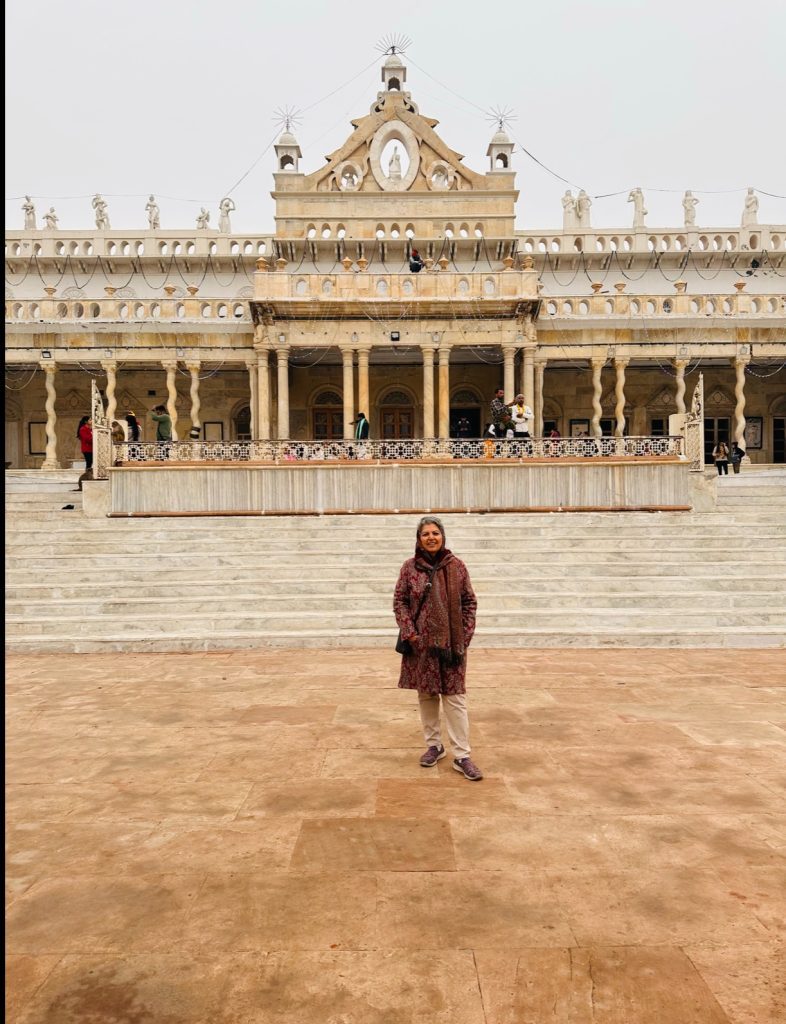
We have all grown up hearing about Awadh’s famed Ganga Jamuni Tehzeeb: for some of us it has been a lived reality.
While I never tire of pointing out to the kamal and kalash on Delhi’s Jama Masjid (and many others monuments including the Taj Mahal) I recently came across this temple in Vrindavan.
I had read about this temple where Awadh met Rome met Braj, but it is something one has to see to understand.
It is the place where Nawab Wajid Ali Shah dances the cosmic dance dressed as a gopi, the Awadh fish emblem supports the crown, and where the rampant lions and statues on the roof remind one of Constantia (La Martiniere Boys College) and a bejewelled Lord Krishna reigns over the hearts of his devotees.

Nawab Wajid Ali Shah as a gopi

As Sugata Ray writes, “Framed by classical pillars, Roman pediments, Solomonic columns, and a Mughal/Awadhi gateway, Krishna thus became the cosmopolitan monarch, an imperial figure of veneration and worship.
This unique temple known as Shah ji ka Mandir after its builder Kundan Lal Shah was completed in 1868.
Kundan Lal Shah had been a treasurer in the court of Awadh’s last Nawab, Nawab Wajid Ali Shah. After the Nawab was exiled to Calcutta by the British East India company and the state annexed by them he moved to Vrindavan.
The entrance is built like Lucknow’s famed Rumi Darwaza.
There are two halls inside: The outer hall has two levels of decorations-
At the lower level are marble inlaid figures of women in various poses as well as one of the builder himself.
Gopis
The builder Kundan Lal Shah as a gopi with an inscription on the shawl edge identifying him
It is however the upper level that held my interest. On a protruding ledge were 12 figures: eleven of the dancing hopis performing a rasleela and the twelfth of the Nawab himself.
We all know that Nawab Wajid Ali Shah composed and performed elaborate plays. Here he would dress up as Krishna as well as the gopis.
In fact as Sugata Ray writes “One of the primary justifications for the 1856 British annexation of Awadh was Wajid Ali’s purported effeminate depravation. A 1857 history of Awadh thus states: “Dressed in female attire, Wajid Ali Shah entered into rivalry with Nautch girls; or trifled in his garden amid swarms of beautiful women draped in transparent gauze, with wings fastened to their shoulders, in humble imitation of female angels.”
This is not how, a fellow Krishna devotee saw his beloved Akhtar Piya Nawab Wajid Ali Shah and he immortalised him in this temple.
As Ray writes, “The symbolism of divine love, where the devotee imagined himself/herself as Radha, Krishna’s consort, created a new vocabulary of religiosity where yearning for the divine, yearning for an absent lover, became the ideal form of bhakti or devotion.”
The sanctum sanctorum bears a close resemblance to imambaras of Lucknow as as those who have visited Lucknow know one enters the Para Imambara through the Rumi Darwaza. The chandeliers and lamps, the elevated shahnasheen all reminded me of the imambaras I visited in Lucknow during the month of Muharram to mourn Imam Hussain.
The marble basin in front of Lord Krishna would once have been linked to flowing water but was dry now.
The Awadh fish emblem
The serpentine columns inspired by the Vatican and lion of Claude Martin’s Constantia : now La Martiniere Boys College, lucknow
My lived reality still lives.

